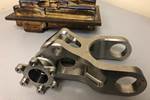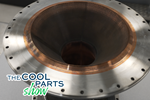Titanium Cheaper Than Aluminum? The Cool Parts Show All Access
General Atomics’ Steve Fournier describes how directed energy deposition makes titanium economical for aircraft structural components.
Which material is the more economical choice becomes counterintuitive when additive manfuacturing is invovled, says Steve Fournier, senior manager of the Additive Design and Manufacturing Center of Excellence for General Atomics Aeronautical Systems Inc. “I am not arguing that the raw material of aluminum is more expensive than the raw material of titanium,” he says, but the total manufacturing cost includes many other factors. Total cost determines when to adopt 3D printed titanium parts like the wing splice described in episode #72 of The Cool Parts Show. In the case of this part, both design advantages and cost savings drove the choice to adopt it in place of what had been a machined aluminum part. When the choice is between 3D printed titanium and 3D printed aluminum, Fournier says, total cost analysis tends to make titanium the cheaper metal, even though the raw material cost is higher. In this video, he makes the argument and describes the relevant factors.
Related Content
-
VulcanForms Is Forging a New Model for Large-Scale Production (and It's More Than 3D Printing)
The MIT spinout leverages proprietary high-power laser powder bed fusion alongside machining in the context of digitized, cost-effective and “maniacally focused” production.
-
3D Printed Cutting Tool for Large Transmission Part: The Cool Parts Show Bonus
A boring tool that was once 30 kg challenged the performance of the machining center using it. The replacement tool is 11.5 kg, and more efficient as well, thanks to generative design.
-
3D Printing Molds With Metal Paste: The Mantle Process Explained (Video)
Metal paste is the starting point for a process using 3D printing, CNC shaping and sintering to deliver precise H13 or P20 steel tooling for plastics injection molding. Peter Zelinski talks through the steps of the process in this video filmed with Mantle equipment.











